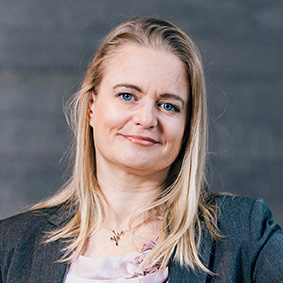Physics professor: Nuclear simulations need powerful computers, and ‘Finland is at the forefront’

Any material subject to high doses of radiation are fundamentally altered at the atomic level.
Be it the circuitry of satellites in the vacuum of space or semiconductors orchestrating the complex machinery in nuclear reactors and particle accelerators, these technologies are dependent on precise electronic interactions.
The Nuclear Materials and Engineering (NuME) group led by Andrea Sand, who was promoted to Associate Professor at Aalto University in Summer 2024, has set out to get a better understanding of how materials are affected by radiation using advanced simulation technologies.
‘Utilizing some of the most powerful computing infrastructure in Europe, our group is shedding new light on how these complex atomic interactions affect a swath of incredibly important industries,’ says Sand.
NuME is the coordinating group behind the €1.5 million European Research Council Starting Grant, titled Comprehensive multiscale modelling of atomistic and electronic structure of radiation-induced defects in semiconductors (MUST). The five-year project began in March 2023.
‘We also have wide-ranging international collaborations, including our partnership in the Eurofusion consortium, which present researchers with valuable opportunities to remain competitive in their respective areas of research,’ she adds.
Bridging gaps in reactor damage modelling and embracing diversity in academia
With a keen interest in electron-ion interactions, doctoral researcher Evgeniia Ponomareva describes her experience in the Nuclear Materials and Engineering (NuME) research group led by Assistant Professor Andrea Sand in the Department of Applied Physics.

Launchpad for career academics
Those who will be most successful in this group are material scientists with computational experience, specifically in the area of computational material science.
When asked about the most attractive prospects for researchers interested in joining NuME, Sand points to the unique career trajectory one can achieve by relocating to Aalto.
‘Our research has benefited from the leap in supercomputing capacity that has developed in the last decade or two,’ Sand says. ‘Finland is actually at the forefront in this regard, as can be seen with CSC - IT Center for Science’s LUMI supercomputer, as well as the Triton computing cluster here at Aalto.’
NuME researchers also have the chance to collaborate with groups at the University of Helsinki and Uppsala University, which both house their own state-of-the-art particle accelerators. These partnerships open opportunities for the NuME group to cross-analyse its simulation work with experimental data.
Now totalling 14 researchers, NuME also offers a strong peer support network that may be difficult to find in smaller group settings.
Contact:


Nuclear Materials and Engineering (NuME)
The Nuclear Materials and Engineering group employs computational methods to study radiation induced processes and damage formation in materials.
- Published:
- Updated:
Read more news

Unite!’s Open Science and Innovation Management Handbook now available online and in print
The handbook is a practical guide for university researchers, R&I support services, and university managers.
Appointments at the School of Chemical Engineering
The School of Chemical Engineering has appointed Jukka Hassinen as Development Manager and Sanna Hellstén as FinnCERES flagship Manager.
What makes nature restorative? Aalto University researchers explore Finnish forests and Japanese gardens
Biodiversity is central to the restorative power of Finnish forests.